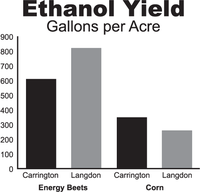Renewable Accounts: Energy Beet Trials Show Significant Results
(Click an image below to view a high-resolution image that can be downloaded)
By David Ripplinger, Bioproducts and Bioenergy Economist and Assistant Professor
NDSU Department of Agribusiness and Applied Economics
I continue to spend part of my time investigating the economic and environmental impacts of beets as an industrial crop. When I got the results of the 2014 yield trials from the Carrington and Langdon Research Extension Centers, I almost fell out of my chair.
Before I get to those numbers, a little background is in order.
A primary goal of the global bioindustry is to produce low-cost, low-carbon sugar that can be used to produce fuels, high-value chemicals, materials and other bioproducts. In the U.S., this sugar comes almost entirely from corn.
There are a number of reasons for this. The first is the American farmer is very good at growing the crop, meaning in almost all years, supplies are ample. Corn is stored and transported easily, has a number of nonindustrial uses, and, depending on the conversion technology, has a number of valuable coproducts such as corn gluten, distillers grain and corn oil. Despite its many advantages, corn isn’t grown everywhere, at least not yet.
For those areas where corn is competitive but less dominant, other biomass may better meet the demand for low-cost, low-carbon sugar. One of the crops being considered is beets.
Back to the trial results. As an economist, I believe the best way to compare alternatives is to price them. That’s difficult to do with a new product made with a new process and a new feedstock.
For the sake of simplicity, we can compare other measures to gauge feasibility. For example, the amount of ethanol produced per acre of beets and corn for Langdon and Carrington may provide insights into their relative competitiveness in these areas.
In Langdon, beets provided enough sugar to produce 934 gallons of ethanol per acre in 2014. Unfortunately, the corn trials were lost to an early frost in 2014, but in 2013, enough corn was produced to make 285 gallons of ethanol.
In Carrington, which is about 100 miles south of Langdon, energy beets yielded the equivalent of 614 gallons of ethanol while corn yielded 495.
While these numbers focus on crop yields, not economic returns, this back-of-the-envelope analysis should raise the interest of those in Carrington and even more so in Langdon.
Of course, in Langdon, canola is king. Neither corn in the south nor canola in the north are going anywhere. Can beets work their way into rotation? That’s a multifaceted question that farmers will need to answer for themselves and is too much to cover in this column.
Regardless of whether a field is planted to corn, canola, beets or other crops, we need to make the most out of every acre we’ve got.
NDSU Agriculture Communication - March 10, 2015
| Source: | David Ripplinger, (701) 231-5265, david.ripplinger@ndsu.edu |
|---|---|
| Editor: | Ellen Crawford, (701) 231-5391, ellen.crawford@ndsu.edu |
Attachments
- PDF - Trials at the Langdon and Carrington Research Extension Centers indicate energy beets could be a competitive crop in these areas. - (389.37890625 kb)
- EPS - Trials at the Langdon and Carrington Research Extension Centers indicate energy beets could be a competitive crop in these areas. - (332.291015625 kb)



